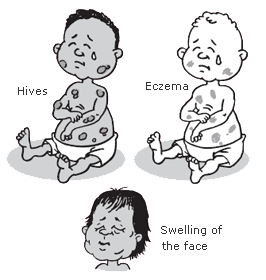 The job of the body’s immune system is to identify and destroy any micro organisms capable of harming the body or causing illness. Food allergy results when the immune system mistakenly targets a harmless food protein, an allergen, as a threat and attacks it. As a result the immune system produces excess amounts of an antibody called immunoglobulin E that fights the “enemy” food by releasing histamine and other chemicals, which trigger the symptoms of an allergic reaction. One in every 17 children, under the age of three, has a food allergy.
The job of the body’s immune system is to identify and destroy any micro organisms capable of harming the body or causing illness. Food allergy results when the immune system mistakenly targets a harmless food protein, an allergen, as a threat and attacks it. As a result the immune system produces excess amounts of an antibody called immunoglobulin E that fights the “enemy” food by releasing histamine and other chemicals, which trigger the symptoms of an allergic reaction. One in every 17 children, under the age of three, has a food allergy.
Many people who think they are allergic to a food may actually be intolerant to it; intolerance more common than allergy. Food intolerance is a non immunoglobulin E mediated food hypersensitivity; this means people with food intolerance suffer symptoms after eating certain foods even when they are not producing antibodies against them. The onset of symptoms is usually slower and may be delayed by many hours after eating the ‘enemy’ food. Symptoms of intolerance may last for several hours or even days.
With intolerance, some people can tolerate a reasonable amount of the food, but if they eat too much or too often they get symptoms because their body can only tolerate small amounts. In allergy, one cannot tolerate even a small amount of the food without suffering symptoms, it only takes a tiny amount to cause a response from the immune system, which makes it very easy to diagnose. A child with an allergy must avoid the allergic food whereas a child with intolerance may be able to eat small quantities without a problem.
Food allergies are more common in people who are atopic, those who have inherited a tendency to have allergic conditions. Such people are more likely to have asthma, various allergies and a skin condition called atopic dermatitis. Asthma can make a reaction to a food more severe. Early introduction of solids to children younger than 6months could increase the risk of allergic disease because the immune system is not fully matured. Smoking or being around second-hand smoke while pregnant increases the unborn child’s risk of developing allergic reactions. Exposing your baby to second-hand smoke after birth also increases the risk.
Children often outgrow the food allergy during early childhood. It is estimated that 80% to 90% of egg, milk, wheat and soy allergies go away by the age of five years. Food allergies are not easy to manage because children react differently, severity also varies from child to child. Some children might react with minor symptoms such as a rash or itching while other children experience severe reactions that if not treated right away, can be life threatening. It is hard to know or predict what type of allergic reaction a child may experience.
The most common symptoms of a food-allergy reaction include: hives, itchy rash, vomiting, itching, abdominal cramps, tingling or swelling of the lips, tongue, or mouth, swelling and diarrhea. However there are some severe symptoms that are not very common that include: wheezing, a drop in blood pressure, trouble breathing, coughing and loss of consciousness
The best way to manage food allergies is through prevention with strict avoidance of the problem foods. Work with a pediatrician to develop a personalized food allergy and anaphylaxis emergency care plan, ensure your child is wearing emergency medical identification at all times e.g. a bracelet or neck piece. Always make sure that the care giver or your child carries their medication wherever they go, give or teach them to take their medicine at the first sign of a reaction. Reading food labels during grocery shopping is also an important task required in preventing food allergies.